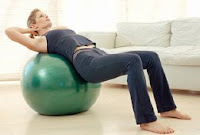PM R. 2009 Jun; 1(6): 541-6Lee SU, Lee JI, Butts K, Carragee E, Fredericson MOBJECTIVE: To determine whether posterior lumbar disk contour dimensions differ in the flexed seated, upright seated, and extended seated positions. DESIGN: Two subgroups of subjects with degenerative disk disease were compared: those with central posterior disk bulge (at L4-5 or L5-S1 levels) and those with a dark nucleus pulposus without posterior disk bulge (L3-4, L4-5, and/or L5-S1 levels). SETTING: Academic medical center. PARTICIPANTS: Eight subjects with a central disk bulge and 9 subjects with a dark nucleus pulposus on magnetic resonance imaging. INTERVENTIONS: Not applicable. MAIN OUTCOME MEASURES: Quantitative comparisons of posterior disk contour between neutral, flexed, and extended sitting positions. RESULTS: Of 8 subjects with central disk bulge, spinal flexion (from the neutral position) produced a decreased disk contour in all subjects, whereas spinal extension (from the neutral position) produced an increased disk contour in 6 subjects, a decreased disk contour in 1 subject, and no measurable change in 1 subject. Changes in posterior disk contour in subjects with a dark nucleus pulposus were variable. Approximately half increased and half decreased, but no relation to position was determined. CONCLUSIONS: The results of this pilot study suggest a consistent pattern of decreased posterior disk contour with spinal flexion and increased posterior disk contour with spinal extension in subjects with central disk bulge, but not in those with a dark nucleus pulposus.



